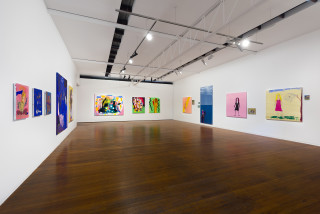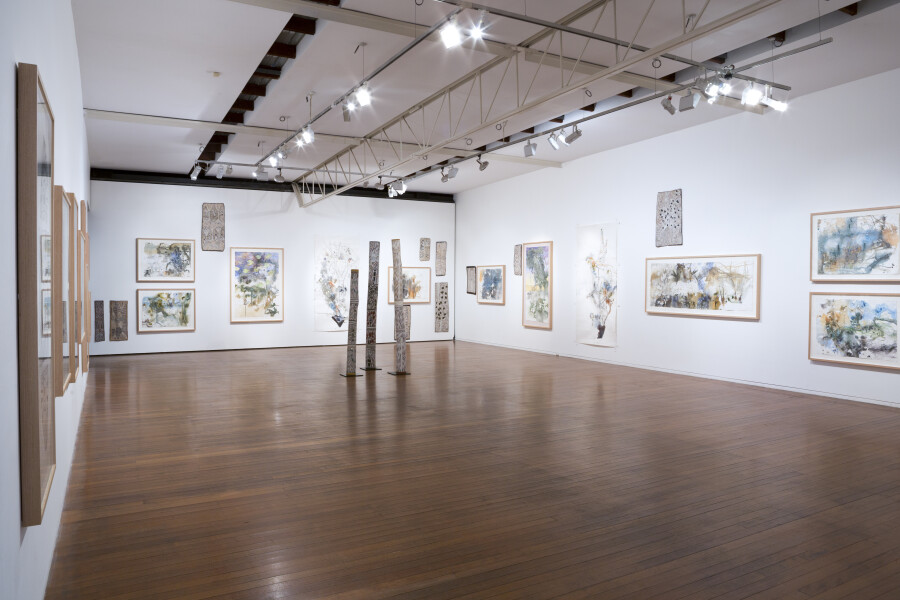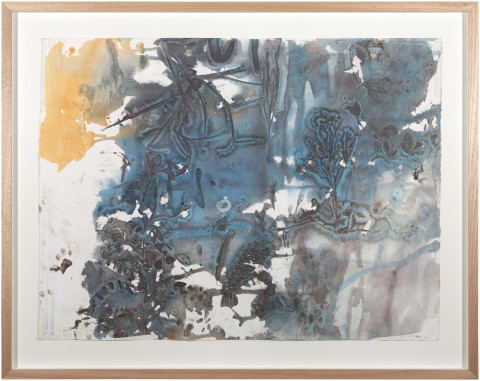An exhibition with Mulkun Wirrpanda.
The same plant, be it mawuka yam or darwirr vine, is viewed through the lens of two completely different world views and two completely different ways of representation.
Exhibition Dates: 29 October – 21 November 2015
This is an exhibition about one of the most wild and powerful landscapes in the world – the monsoon rain forests and floodplains of East Arnhem Land – as seen through the different lenses of two of Australia’s most distinguished senior artists. Large watercolours, woodcuts, bark paintings and larrakitj image the essential nature and dynamic energy of a range of endemic tropical plants with their yams, edible tubers, and fruits. The works surround the visitor to the exhibition – Wirrpanda’s images of particular plants juxtaposed with Wolseley’s drawings and paintings of the same species. For example, her bark showing one of the region’s huge yams, manmuna in the Yolnu language, has luxuriant heart shaped leaves which almost morph into the tumbling foliage of Wolseley’s nature print of the same plant beneath it. Likewise a painting on bark of an ancient cycad with its exuberant fruits suggests a line of connection across the gallery to a drawing by Wolseley of another cycad species reflected in the still dark water of a forest pool.
When the artists first met, Wirrpanda had already started to paint an epic series of bark paintings and larrakitj about the plants of her homeland: a small section of which is included in this exhibition. This is a powerful group of paintings which demonstrates her urgent and passionate desire to pass on to new generations her vast knowledge before it is lost.
Mulkun Wirrpanda is a senior female artist for the Dhudi-Djapu clan from Dhuruputjpi. She is an acknowledged leader of her clan and has a lifetime’s knowledge of her country. This vast knowledge is distilled into her works. One of many lasting legacies of her recent body of works dealing with food plants is that this information will be preserved for the future generations. It is particularly important for those plants that are no longer collected or valued in the way they had been in the past. For example the works depicting wild orange or bunjunu which was an important food in her youth. She has often spoken in a heartfelt way about how this is one of the main purposes of her art.
John Wolseley has lived and worked all over the continent and is known for his large scale works on paper which relate the minutiae of plant, bird and insect to the greater movements of the earth’s geological and ecological systems. Wolseley and Wirrpanda first met in 2009 when John was in Baniyala as one of a group of Yolnu and balanda and visiting artists working on the wonderful project and touring exhibition Djalkiri – We are standing on the their names – organised by Nomad Art of Darwin.
As part of this project, the artists, scientists and anthropologists were hosted by Djambawa Marawili. They drew and worked on their etchings and lithographs around Blue Mud Bay and later in the Buku-Larrnggay Mulka Centre in Yirrkala. After a day spent harvesting tubers and yams, Wirrpanda asked Wolseley to be her wawa or brother and gave him the name of Langgurrk; a type of beetle grub which lives in mud and yams. Since then they have met each year in the Midawarr season, wandering through rainforest and floodplain, collecting and painting the rich diversity of yam, tuber and fruit.
The artists have also collaborated in a series of woodcuts on Huon pine, The Midawarr – Harvest Series. Seven large prints by Wirrpanda and four by Wolseley celebrate the same edible plants.
For this series Wolseley took huge slabs or blocks of Huon Pine from Tasmania to Yirrkala where Wirrpanda and Wolseley then engraved their woodcuts into these rough wood blocks. They were then proofed and printed by Annie Studd and the Yolnu printmakers at the Buku-Larrnggay Mulka Centre Print Workshop and by John Wolseley at his studio in Victoria with the help of printmakers Kaitlyn Gibson and Cassandra Gill.
Two of Mulkun’s prints Rakay # 2 and #3 are printed on stringybark made by Winsome Jobling, the Darwin based paper artist. Something extraordinary happens when the work is printed on paper made from the actual place rather than imported European papers from France or Italy.
During this time Wolseley also took on the viewpoint of the Langgurrk, in a number of prints made directly from ‘life histories’ engraved by beetles under the bark of trees. The Boring Beetle and Moth Compendium 2015 is a group of relief prints showing the progression of changes undergone by a beetle during its lifetime. In a fallen branch randomly chosen from the forest floor, he has found a whole world in miniature form. An epic story of birth and transformation which brings to mind the connection that the ancient Egyptians saw between the scarab beetles rolling a ball of dung across the ground and the way the sun rolls across the sky and is reborn each dawn.
Though coming from very different directions, there are correspondences and synchronies between the works of these two artists. In a curious way, aspects of the scientific foundation of the European tradition correspond to elements in Wirrpanda’s Yolnu approach. Her depiction of plants and their habitats reveal her huge knowledge of seasonal changes, morphologies and types of energy. Howard Morphy has recognized the complexity of this knowledge system; pointing to the Yolnu ’belief that the surface forms of things derive from underlying structures and relationships’. In several of his works Wolseley refers to earlier artists and scientists and he sometimes says that he likes to play along the boundary between art and science. In The Power of Movement in Plants – Discorides’ Yam Climbing Leonardo’s tree Wolseley references what could be described as one of the great originary drawings from the dawn of science – the tree Leonardo da Vinci drew when thinking about the growth of trees, branches, river systems, and vascular systems. In the companion work The Power of Movement in Plants – Dioscorides’ Yam with Darwin’s Diagram, he has used one of the methods which Charles Darwin employed to document the movement of plants. In this painting the dance of a vine as it climbs up to the sun is shown in a form of choreographic notation.
In this exhibition the same plant, be it mawuka yam or darwirr vine is viewed through the lens of two completely different world views and two completely different ways of representation. Wirrpanda’s art flows from a culture that has evolved over thousands of years out of the country itself. Wolseley’s art is part of the European landscape tradition based on the study of the physical and natural world through observation and experience.
An important connection between these artists is a strong belief in the originary and primary importance of the natural world – its plants, animals and eco-systems. And a shared awareness of how our accelerating loss of connection with country will result in damage beyond repair.
‘The task of the artist is to keep and repair the sacred web of creation’ – George Mackay Brown
—
John Wolseley (b. 1938) is one of Australia's most well-respected contemporary artists. In 2005, he was made an Honorary Doctor of Science by Macquarie University and was also awarded the Visual Art Emeritus Award by the Australia Council. Wolseley recently exhibited a solo show at the National Gallery of Victoria titled Heartlands and Headwaters and his work has been selected for numerous important group exhibitions such as Dobell Australian Drawing Biennial, Art Gallery of New South Wales, Sydney (2014), International Print Exhibition, Australia and Japan, Kyoto Municipal Museum of Art, Kyoto, Japan; Fukiyama Museum of Art, Hiroshima, Japan (2014), The Skullbone Experiment, UNSW Galleries, Sydney (2014), The 18th Biennale of Sydney: all our relations, curated by Catherine de Zegher and Gerald McMaster, Sydney (2012), and Reframing Darwin: evolution and art in Australia, at The Ian Potter Museum of Art in Melbourne (2009). A major monograph, John Wolseley: Land Marks by Sasha Grishin was published in 1998 by Craftsman House, a second, expanded edition was published in 2006 and a third edition in 2015. John Wolseley's work is represented in all the major state galleries and in numerous private collections in Australia and internationally. Marrma dilakmala larruma gurra nathawu - Two Old Artists Looking for Food is John Wolseley's sixth exhibition with Roslyn Oxley9 Gallery.
Mulkun Wirrpanda is a senior female artist for the Dhudi-Djapu clan for Dhuruputjpi. She is a daughter of the late Dhäkiyarr Wirrpanda and widow to Wakuthi Marawili, a Mau1e0farrpa clan leader who lived at Yilpara until his death in mid-2005. She is also the mother (by kinship) to senior artist and clan leader Djambawa Marawili. Mulkun paints
Dhudi-Djapu miny’tji (sacred design) that depicts her land at Dhuruputjpi. As the eldest and most knowledgeable of her clan, she is acknowledged as a leader. Mulkun is one of the few Yolu014bu women to have this status. Mulkun was an early practitioner of works without figurative imagery within the miny’tji. Until recently the painting of this ‘raw’ miny’tji was restricted to ceremonial use. The work is always done using natural earth pigments (ochres). Yalata and Darrangi are areas she usually paints, which are at her clan estate Dhuruputjpi, where she resides. Mulkun paints on bark, larrakitj (memorial poles) and yidaki (didjeridus) and is a talented carver, weaver and print-maker. Her works has been exhibited throughout Australia and Asia.

relief prints on gampi and mulberry paper and suspended wood elements
dimesnions variable

watercolour, graphite, plant leaf on paper
97 x 221 cm

watercolour and plants on paper
97 x 320.5 cm


watercolour with graphite rubbing overlay on paper
188 x 101 cm

from the series Midawarr Suite
lino cut and wood cut
162 x 60 cm
Edition of 40

watercolour, graphite, oil paint and plant material on paper
235.5 x 114 cm

watercolour, oil paint and linocut on paper
262 x 114 cm








relief print and watercolour on paper
Edition of 20 + 1 AP


from the series Midawarr Suite
relief print on paper
103 x 71 cm
Edition of 30
 Group Show, Works on Paper
Group Show, Works on Paper
Roslyn Oxley9 Gallery, 2024-25
 Group Show, The First 40 Years
Group Show, The First 40 Years
Roslyn Oxley9 Gallery, 2024
 Group Show, The Winter Bride
Group Show, The Winter Bride
Roslyn Oxley9 Gallery, 2023
 Group Show, A Painting Show
Group Show, A Painting Show
Roslyn Oxley9 Gallery, 2020-21
 Group Show, The Like Button
Group Show, The Like Button
Roslyn Oxley9 Gallery, 2018-19
 Group Show, State of Play
Group Show, State of Play
Roslyn Oxley9 Gallery, 2017
 Group Show
Group Show
Roslyn Oxley9 Gallery, 2016
 Group Show
Group Show
Roslyn Oxley9 Gallery, 2015
 Group Show, Never-Never Land (A Collaboration with Utopian Slumps)
Group Show, Never-Never Land (A Collaboration with Utopian Slumps)
Roslyn Oxley9 Gallery, 2014
 Group Show, Dawson, Griggs, Moore
Group Show, Dawson, Griggs, Moore
Roslyn Oxley9 Gallery, 2013
 Group Show, Cronies
Group Show, Cronies
Roslyn Oxley9 Gallery, 2012
 Group Show, Groups Who
Group Show, Groups Who
Roslyn Oxley9 Gallery, 2011-12
 Group Show, Head On Photography Festival
Group Show, Head On Photography Festival
Roslyn Oxley9 Gallery, 2011
 Group Show, True Story
Group Show, True Story
Roslyn Oxley9 Gallery, 2010-11
 Group Show, Everything's Alright
Group Show, Everything's Alright
Roslyn Oxley9 Gallery, 2010
 Group Show
Group Show
Roslyn Oxley9 Gallery, 2009-10
 Group Show, Lucky Town
Group Show, Lucky Town
Roslyn Oxley9 Gallery, 2008-09
 Group Show, OBLIVION PAVILION
Group Show, OBLIVION PAVILION
Roslyn Oxley9 Gallery, 2008
 Group Show, Summer '07 '08
Group Show, Summer '07 '08
Roslyn Oxley9 Gallery, 2007
 Group Show, STOLEN RITUAL
Group Show, STOLEN RITUAL
Roslyn Oxley9 Gallery, 2006-07
 Group Show, Rectangular Ghost
Group Show, Rectangular Ghost
Roslyn Oxley9 Gallery, 2006
 Group Show
Group Show
Roslyn Oxley9 Gallery, 2005
 Group Show, If these walls could talk
Group Show, If these walls could talk
Roslyn Oxley9 Gallery, 2005
 Group Show, Z
Group Show, Z
Roslyn Oxley9 Gallery, 2003
 Group Show, Dirty Dozen
Group Show, Dirty Dozen
Roslyn Oxley9 Gallery, 2002
 Group Show, The First 20 Years
Group Show, The First 20 Years
Roslyn Oxley9 Gallery, 2002
 Group Show, All Stars
Group Show, All Stars
Roslyn Oxley9 Gallery, 2000
 Group Show, more apt to be lost than got
Group Show, more apt to be lost than got
Roslyn Oxley9 Gallery, 2000
 Group Show, Gang of Four
Group Show, Gang of Four
Roslyn Oxley9 Gallery, 1999
 Group Show, Every other day
Group Show, Every other day
Roslyn Oxley9 Gallery, 1998
 Group Show
Group Show
Roslyn Oxley9 Gallery, 1997
 Group Show, A constructed world (in collaboration with John Wolseley)
Group Show, A constructed world (in collaboration with John Wolseley)
Roslyn Oxley9 Gallery, 1997
 Group Show, Young British Artists
Group Show, Young British Artists
Roslyn Oxley9 Gallery, 1996
 Group Show, Stockroom
Group Show, Stockroom
Roslyn Oxley9 Gallery, 1995
 Group Show, Blow Up
Group Show, Blow Up
Roslyn Oxley9 Gallery, 1995
 Group Show, Photosynthesis
Group Show, Photosynthesis
Roslyn Oxley9 Gallery, 1994
 Group Show, Queerography
Group Show, Queerography
Roslyn Oxley9 Gallery, 1994
 Group Show, 115 58' EAST 31 56' SOUTH
Group Show, 115 58' EAST 31 56' SOUTH
Roslyn Oxley9 Gallery, 1993
 Group Show, High pop
Group Show, High pop
Roslyn Oxley9 Gallery, 1993
 Group Show
Group Show
Roslyn Oxley9 Gallery, 1992
Group Show, T.I.S.E.A.
Roslyn Oxley9 Gallery, 1992
Group Show, Abstract Art
Roslyn Oxley9 Gallery, 1992
 Group Show, Christmas show
Group Show, Christmas show
Roslyn Oxley9 Gallery, 1991
 Group Show, Ramingining Bark Paintings and Sculpture
Group Show, Ramingining Bark Paintings and Sculpture
Roslyn Oxley9 Gallery, 1991
 Group Show, Ramingining
Group Show, Ramingining
Roslyn Oxley9 Gallery, 1991
 Group Show
Group Show
Roslyn Oxley9 Gallery, 1990
 Group Show, Strange harmony of contrasts
Group Show, Strange harmony of contrasts
Roslyn Oxley9 Gallery, 1990
 Group Show, Recent Works from Ramingining and Maningrida
Group Show, Recent Works from Ramingining and Maningrida
Roslyn Oxley9 Gallery, 1989
 Group Show, The Cocktail Party (All Gallery Artists)
Group Show, The Cocktail Party (All Gallery Artists)
Roslyn Oxley9 Gallery, 1988
 Group Show, 7th Biennale of Sydney
Group Show, 7th Biennale of Sydney
Roslyn Oxley9 Gallery, 1988
Group Show, Mardi Gras exhibition
Roslyn Oxley9 Gallery, 1988
 Group Show, 1968-1988 Selected works
Group Show, 1968-1988 Selected works
Roslyn Oxley9 Gallery, 1988
Group Show, Video Festival
Roslyn Oxley9 Gallery, 1987
 Group Show, Chaos
Group Show, Chaos
Roslyn Oxley9 Gallery, 1987
 Group Show, A Resistant Spirit
Group Show, A Resistant Spirit
Roslyn Oxley9 Gallery, 1986
 Group Show, The Forbidden Object
Group Show, The Forbidden Object
Roslyn Oxley9 Gallery, 1986
Group Show, Yuletide nuptials fashion show
Roslyn Oxley9 Gallery, 1985
Group Show
Roslyn Oxley9 Gallery, 1984
 Group Show, Dreams and Nightmares
Group Show, Dreams and Nightmares
Roslyn Oxley9 Gallery, 1984
Group Show, Young artists
Roslyn Oxley9 Gallery, 1983
























































